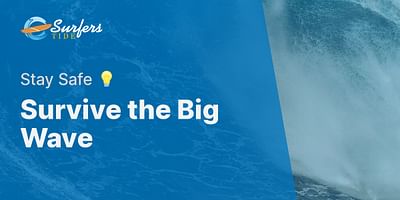Malia Koa is a professional longboarder, surf photographer, and travel enthusiast. Born in Hawaii and raised in a family of surfers, Malia has a deep connection to the ocean and the surfing community. She loves capturing the beauty of the sport through her lens and inspiring others to embrace the surfer lifestyle.
Hey there, fellow wave rider! I totally get it - sometimes Mother Nature throws us a curveball and the weather conditions at our favorite surf spot aren't exactly ideal. But fear not, because us surfers have a few tricks up our sleeves to cope with those challenging weather conditions. Let me share some techniques with you!
First things first, it's crucial to stay safe out there. When the weather gets rough, it's important to assess the conditions before paddling out. Keep an eye on the swell size, wind direction, and tide. If it's too dangerous or beyond your skill level, it's better to sit it out and wait for better conditions. Safety should always be our top priority.
Now, let's talk about some techniques to help you navigate the challenging weather conditions when you do decide to paddle out. One of the most important things is to adjust your surfing technique to match the conditions. Here are a few tips:
Surfing Techniques for Different Weather Conditions
| Weather Condition | Technique | Equipment | Tips |
|---|---|---|---|
| Sunny and Calm 🌞 | Long, smooth strokes | Longboard | Apply sunscreen and stay hydrated |
| Windy and Choppy 🌬️ | Short, quick strokes | Shortboard | Be cautious of wind direction |
| Rainy 🌧️ | Steady, balanced stance | All-round board | Avoid lightning storms |
| Big Swells 🌊 | Deep paddle, duck dive | Gun board | Practice breath control |
| Cold Weather ❄️ | Paddle harder to stay warm | Wetsuit | Keep moving to maintain body heat |
1. Positioning: In bad weather, the waves can be unpredictable, so it's crucial to position yourself correctly. Look for channels or sandbars that can provide some shelter from the wind or current. This will help you find more manageable waves and make your session more enjoyable.
2. Paddle power: Challenging weather often means stronger currents and choppy waves. To overcome these obstacles, you'll need to increase your paddle power. Focus on your technique, using long, powerful strokes to generate more speed and maintain control. Building upper body strength through regular exercise will also help you power through those challenging conditions.
3. Adjust your stance: When the wind is blowing hard or the waves are choppy, it's important to adjust your stance on the board. Keep your weight centered and low, with your knees slightly bent. This will help you maintain stability and control, even in gusty conditions.
4. Equipment: Having the right gear can make a world of difference in challenging weather conditions. Consider using a slightly larger board with more volume to help you paddle faster and catch waves more easily. Additionally, investing in a good quality wetsuit will keep you warm and comfortable, even in colder or windier conditions.
5. Mental preparation: Coping with challenging weather conditions requires mental resilience. Stay focused, positive, and adaptable. Embrace the challenge and see it as an opportunity to improve your skills. Remember, every wave is a learning experience, regardless of the weather.
Lastly, don't forget to have fun! Surfing in challenging weather conditions can be an exhilarating experience. Embrace the elements, challenge yourself, and enjoy the unique beauty of the ocean in all its moods.
So, my fellow surfer, armed with these techniques, you'll be ready to tackle any challenging weather conditions that come your way. Stay safe, stay stoked, and keep chasing those waves!















